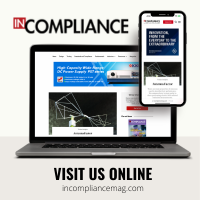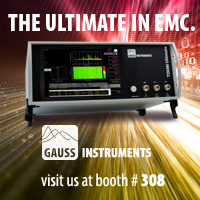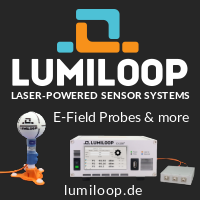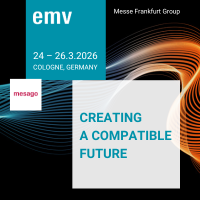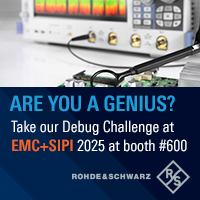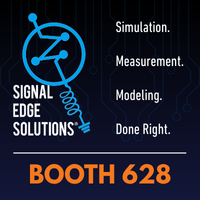Experiments & Demonstrations
You will not want to miss the popular Experiments and Demonstrations program that will be held in the Exhibition Hall. This hands-on activity provides a unique learning experience that complements the technical presentations at the Symposium. It is traditionally one of the educational highlights of the Annual Symposium!
This year at the Symposium we are pleased to announce that we will be showcasing 24 Experiments and Demos. We will have 5 stages, with 2-hour slots in the mornings and afternoons. The presentations cover a wide spectrum of topics related to Signal Integrity & Power Integrity, Aerospace, Military, Automotive, Material Properties, Wireless Communications, Test Methods, Simulation and much more.
We encourage you to join us and make Experiments & Demos an integral part of your Symposium experience!
Tuesday, August 19, 2025
(ED_A1) Modeling of High-Altitude Electromagnetic Pulse (HEMP) Threat, Test Setup, and Its Effects for Aid in the Design of Airborne Equipment
Presenter(s):
Dr. CJ Reddy, Altair, USA
Henry Soekmadji, Collins Aerospace, USA
Location: E&D Booth 1
Time: 9:30 AM – 11:30 AM
HEMP phenomenon can be broken down into two types, radiated and conducted emissions. This demo showcases the modeling and simulation to analyze the problem when an airborne equipment is tested per MIL-STD-461 RS105 method. During the demo, we will use the airborne equipment, an Integrated Drive Generator (IDG) with apertures and cabling. We simulate the effects of the penetrated radiated EMP into the IDG’s cavity and its resonant cavity mode coupling to the internal wiring. This method/workflow will be demonstrated using Altair Feko to aid the design of the IDG and its controller against HEMP. We will illustrate computationally efficient combined Method of Moment (MoM) and Multi Transmission Line (MTL) technology solution for the analysis of emissions. This demonstration will highlight several simulation challenges and solutions for modeling High-Altitude Electromagnetic Pulse (HEMP) threat to aid the design of IDG for airborne application.
(ED_A2) Using Simulated EMC Instruments to Develop, Edit, and Validate EMC Test Routines – Including Evaluation of Test Data for Boresight and Alternate Antenna Height Scan Measurements as per ANSI C63.4
Presenter(s):
Jack McFadden, ETS-Lindgren, USA
Bob Mitchell, TUV Rheinland AG, Germany
Location: E&D Booth 2
Time: 9:30 AM – 11:30 AM
Automating the EMC test process has the benefits of improving measurement accuracy and repeatability while also increasing test throughput. EMC testing is complex and requires multiple instruments to work in unison so that data gathered is coherently assembled to determine compliance of a device under test. Integrity of the test setup is typically done with system checks where a known signal is injected at some point in the system and compared with expected results. This approach is great for validating the entire hardware/software signal chain. Using virtual instruments, the software side of the system can be validated before assembling the instrumentation. This is a significant time saver and allows for scenario testing without tying up test equipment and chamber time.
This demonstration will show how instrument simulation can be used to setup system checks as well as validate actual EMC emissions and immunity tests.
In addition, as an example, actual test data using automated EMC test software will be shown comparing boresight measurements (currently per C63.4) and alternate antenna height scan measurements (under consideration for C63.4) taken during a recent live demonstration in the new 10meter chamber at TUV Rheinland, Boxborough, MA.
(ED_A3) Modern Automated Test Techniques to Address ISO 11451-5, Annex G
Presenter: Garth D’Abreu, ETS-Lindgren, USA
Location: E&D Booth 3
Time: 9:30 AM – 11:30 AM
Annex G of ISO 11451-5 Road Vehicles – Vehicle Test Methods for the Electrical Disturbances from Narrowband Radiated Electromagnetic Energy – Part 5: Reverberation Chamber Edition 2022 included new techniques to expand the scope of testing to this standard. This hardware demonstration describes a highly efficient test and measurement system meeting Annex G, Reverb Method with Closed-Loop Power Control, for fast data acquisition.
The speaker will review the essential instrumentation required for improved testing, namely high-speed field probes and high-speed tuner(s), as well as enhanced software to automate the test process.
Demonstration attendees will learn about the advantages of a novel ISO 11451-5 test and measurement system solution, including:
- Lower useable frequency — (LUF) may be extended
- Higher efficiency — Simultaneous calibration loading and test measurements
- Higher accuracy — Less field variations with high-speed tuner(s)
- Greater test control
(ED_A4) Automotive Electrical Transients on Power Bus Mitigation to Protect Sensitive Electronics
Sponsored by TC-7
Presenter(s):
Scott Carlson, Element Materials Technology, USA
Location: E&D Booth 4
Time: 9:30 AM – 11:30 AM
A practical comparison of protection methods for sensitive electronics connected to the automotive power buss. This will be a demonstration of the transients specified in ISO 7637-2 and ISO 16750-2 applied to a various protection circuits and measuring the amplitude of the transient that escapes pass the protection circuits into the sensitive electronics. The protection circuits will be made and designed with components readily available at any electronics supplier.
The premise of this experiment is that the voltage that makes it beyond the transient protection may destroy the devise under test.
(ED_A5) Delve into Software Gating: Flexibility Meets Performance!
Presenter(s):
Yibo Wang, ETS-Lindgren
Andrew Shyne, The Boeing Company, USA
Garret McKerricher, ETS-Lindgren
Location: E&D Booth 5
Time: 9:30 AM – 11:30 AM
Time-domain gating is a well-known technique for isolating responses and is commonly integrated into commercial vector network analyzers (VNAs). However, once data is downloaded, users often have limited options for further processing. To address this limitation, we have developed a versatile gating library that offers enhanced flexibility and seamless integration with popular programming environments. A key issue in time-domain gating is the band edge effect caused by limited measurement bandwidth. To address this, the library incorporates standard edge treatment techniques and introduces the patented Spectrum Extension Edgeless Gating (SEEG) method, which significantly reduces edge artifacts. Beyond time-domain applications, the library also excels in spatial and spectral analyses. The demonstration will feature real-time gating, with parameters adjustable via MATLAB, Python and C. We will compare outputs from conventional edge renormalization techniques and SEEG, showcasing the advantages of the latter. We will demonstrate the gating library using a low-cost hobbyist NanoVNA, which is included in the IEEE EMC Society Inductance Testing PCB Kit. A small tool will be demonstrated to read NanoVNA data and enable time-domain processing. Both the tool and a free version of the gating library will be provided to attendees. This demonstration will highlight the practical applications of the newly developed gating library and provide attendees with hands-on experience in real-time processing.
(ED_B1) Absorbing Materials and Specialty Silicone Composite, Materials as Terminations for FEXT and NEXT Measurements
Sponsored by TC-10
Presenter(s):
Daniel L. Commerou, Missouri University of Science and Technology, USA
Julia Sunderland, The Dow Chemical Company, USA
Location: E&D Booth 1 (Exhibit Hall)
Time: 2:30 PM – 4:30 PM
Numerous types of materials, including metallic, polymeric composites and electrically conductive silicones, can be utilized to mitigate and control electromagnetic shielding interference. In this demonstration, absorbing materials and specialty silicone composite materials will be demonstrated for use in signal integrity termination for FEXT and/or NEXT measurements as an alternative to screw on SMA terminations.
(ED_B3) EMC Compliance Out of the Box, Inside a Metal Box
Presenter(s):
Scott Piper, Dassault Systemes, USA
Location: E&D Booth 3
Time: 2:30 PM – 4:30 PM
Electronic devices are designed to meet EMC requirements on their own, but in many cases the device needs to be inside a metal box for one reason or another which then becomes a major aspect of their EMC compliance. While these metal boxes are generally helpful, housing material, apertures, and pesky wiring can wreak havoc being a liability for both radiated emissions and susceptibility therefore the importance of knowing the impact of these boxes is clear! In this demonstration, we will examine typical housing features using both hardware and electromagnetic simulation to explain the effects of these features and impact on EMC compliance.
(ED_B4) Hardware Demonstration: Time Domain vs. Frequency Domain
Sponsored by TC-8
Presenter(s):
John C. McCloskey, Jen Dimov, NASA, USA
Location: E&D Booth 4
Time: 2:30 PM – 4:30 PM
The two primary “domains” we have for observing electrical signals are the time domain, as observed with an oscilloscope, and the frequency domain, as observed with a spectrum analyzer. A solid understand of both domains, along with a solid understanding of how the two domains relate to each other through the Fourier Transform and Fourier Series Expansions, is crucial for a complete understanding of the behavior of electrical signals.
This demonstration will provide an overview of the Fourier Transform and Fourier Series Expansions followed by measurements of representative signals in both the time and frequency domains in order to show agreement with theoretical models. Once this relationship is demonstrated, these theoretical models provide useful and powerful analytical tools that can come in handy especially in situations in which direct measurements may not be feasible.
(ED_B5) Demonstrating Proper Probe Placement is Paramount in Practical Systems
Presenter(s):
Christopher J. Semanson, Renesas Electronics America Inc., USA
Location: E&D Booth 5
Time: 2:30 PM – 4:30 PM
The proposed experiment will illustrate how probe loading can present challenges when measuring signals in electrical systems. The demonstration will employ a Curl-E box, which comprises:
- An AM Ferrite Road Antenna
- A project box equipped with measurement hooks
- A signal generator
This setup will highlight how a common oscilloscope probe can inadvertently create a loop during measurement—formed by the probe tip and the pigtail or reference clip. By orienting two probes in opposite directions the result will be as shown below. The flux generated by the ferrite rod antenna will intersect the surface area of each probe and the circuit, inducing a voltage.
Due to the specific orientation of the probes, one will display a sine wave while the other will show a phase-shifted waveform resembling a cosine wave (nearly 180° out of phase with the first), caused by the magnetic flux passing through the probe loop. This demonstration and explanation are crucial because many early to mid-career engineers have yet to learn proper probing techniques. Often, they simply attach their leads to a test point and leave them in the circuit, which can result in erroneous measurements.
Additionally, the lecture will provide an overview of probe non-idealities and probe construction, further underscoring the importance of proper measurement techniques.
Wednesday, August 20, 2025
(ED_C1) Mastering Shielding Cabinet: A Hands-On on Cavity Resonance
Sponsored by TC-4
Presenter(s):
Victor Martinez Garcia, Wurth Elektronik eiSos GmbH & Co KG, Germany
Jared Quenzer, Würth Elektronik, USA
Location: E&D Booth 1 (Exhibit Hall)
Time: 9:30 AM – 11:30 AM
As electronic components become increasingly compact on printed circuit boards (PCBs), the risk of electromagnetic interference (EMI) due to unintended coupling rises. To optimize the performance of integrated circuits (ICs) and ensure electromagnetic compatibility (EMC), board-level shields (BLS) are crucial in mitigating EMI in PCB designs. The shielding cabinet, or shielding can, is the most common BLS component. By connecting to the PCB’s reference plane, it forms five of the six walls needed for a Faraday cage. While effective in shielding, it can cause undesired cavity resonance issues.
Join this tutorial for exploring the impact of cabinet dimensions on cavity resonance frequency for knowing how to face this issues in your projects.
(ED_C2) Aircraft Lightning Induced Transient Susceptibility: A Novel Method for Power Pins Testing
Presenter(s):
Adrian Matoi, EMC Partner AG, Switzerland
Patrick Bolliger, HV Technologies, Inc., USA
Location: E&D Booth 2
Time: 9:30 AM – 11:30 AM
In order to perform as intended, electric and electronic systems from aircraft require, among others, testing against lightning induced transients. There are two main types of tests described in RTCA DO-160 and similar standards: pin injection and cable induction tests. This demonstration introduces a novel method to performing tests on power pins, and focuses on the relevance of power source protection elements and their influence on calibration results.
(ED_C3) Measuring Differential and Common Mode Conducted Emissions from DC-DC Converters
Presenter(s):
Michael Schnecker, Rohde & Schwarz, USA
Location: E&D Booth 3
Time: 9:30 AM – 11:30 AM
DC-DC converters are commonly used to supply power to high speed GPUs and other processors. The high currents delivered to these devices often produces large wideband conducted emissions. This experiment will demonstrate how to use a 2-channel DC LISN and an oscilloscope to measure the common mode and differential mode conducted emissions and the proper use of input filtering to mitigate these effects.
(ED_C4) Simulation of Radiated Emissions for EV Powertrain
Sponsored by TC-9
Presenter(s):
Jaehoon Kim, C.J. Reddy, Altair Engineering Inc., USA
Location: E&D Booth 4
Time: 9:30 AM – 11:30 AM
An electric vehicle (EV) powertrain is a traction power system providing moving power to an EV by converting electric energy into mechanical motion. The powertrain is basically composed of a battery system, DC/AC inverter, an electric motor, and DC/AC power buses. The battery is a high DC voltage source and the inverter is designed to accomplish the DC-to-AC conversion which is needed to operate the electric motor. The DC bus connects between the battery and the inverter, whereas the AC bus exists between the inverter and the electric motor in the form of a three-phase line. Since the inverter is a fast switching device to generate a high power oscillating signal, the inverter is known as a significant electromagnetic(EM) interference source. Furthermore, it is easily anticipated that the high power signal is mainly radiated from the AC power bus next to the inverter. Therefore, it is highly required to set up the radiated emission (RE) procedure of the EV powertrain in the early EV design stage with capable simulation tools.
This software demonstration introduces a hybrid method, combining the circuit analysis of the EV inverter system (using Altair PSIM) and the EM simulation (using Altair Feko) to estimate the RE of the EV powertrain system. The powertrain system is represented by its equivalent circuit models to calculate the electric signals generated in the system, which are used as the source of the main radiated field evaluation with the CISPR 25 RE setup. Additionally, an integrated electric drive module (EDM) is presented in terms of how effectively the module reduces the RE of the EV powertrain.
(ED_C5) Low Cost Tools for EMC Troubleshooting
Sponsored by TC-3
Presenter(s):
Karen Burnham, Electro Magnetic Applications, Inc., USA
Location: E&D Booth 5
Time: 9:30 AM – 11:30 AM
This demonstration will show off some low cost tools that can assist with EMC troubleshooting. You don’t need tens of thousands of dollars worth of equipment to get a sense of what’s in the RF environment, either in terms of radiation surrounding a piece of equipment or conducted noise on cabling. The main focus will be on low cost software defined radio (SDR) devices that are easily available, along with some accessories that can make them more illuminating when tracking down EMC issues.
(ED_D1) Speed Up Your RC: Closed-Loop E-Field Control in Reverberation Chambers
Presenter(s):
Samuel Hildebrandt, LUMILOOP GmbH, Germany
Location: E&D Booth 1 (Exhibit Hall)
Time: 2:30 PM – 4:30 PM
The demo session will start with a brief introduction on the basics of reverberation chambers (RCs). Validation and radiated immunity testing are discussed.
We will bring a small, but fully working, stirred RC to the stage. Eight fast, synchronized electric-field probes will showcase real-time E-field strength measurements and closed loop E-field control based on statistics. LUMILOOP’s LSProbe E-field Probes enable accelerated measurements according to ISO 11451-5.
The reverb chamber basics will also be visualized using live measurements, helping to quickly grasp how the invisible electric field behaves.
Learn on how to improve your EMC measurement. Save time and money while testing!
(ED_D2) Good Idea? Ground planes under a CMC.
Presenter(s):
Jared Quenzer, Würth Elektronik, USA
Location: E&D Booth 2
Time: 2:30 PM – 4:30 PM
Ground planes under a common mode choke (CMC) can create a path for electrical noise to bypass the CMC. Let’s investigate what causes this and diagnose what variables affect noise coupling to the ground plane:
(A) What layer is acceptable to use on a 4 layer PCB (Z direction)?
(B) How far away from the CMC in the X,Y direction should the keepout zone be?
Let’s test with a real PCB and also do some Finite Element Analysis simulations to find empirical answers to these questions.
(ED_D3) Microstrip Pulse Propagation Experiments with the NanoVNA in Transient Mode
Sponsored by Education Committee
Presenter(s):
Robert Olsen, Washington State University, USA
Location: E&D Booth 3
Time: 2:30 PM – 4:30 PM
In this demonstration Nano VNA (in transient mode) will be used to study some characteristics of pulse propagation on four microstrip boards. Designs for the four boards will be available to anyone who is interested.
The four boards have:
- Two lengths of microstrip line (Z0 = 50 Ω and 100 Ω)
- A single length of microstrip line (Z0 = 50 Ω ) with a 90 degree angle
- A single length of microstrip line (Z0 = 50 Ω ) with a short circuited stub connected at the center
- A set of two parallel (closely coupled) microstrip lines (Z0 = 50)
This equipment will be used to demonstrate:
- Propagation time and velocity factor of the dominant quasi-TEM microstrip mode
- Reflections at junctions with discontinuities in impedance
- Model attenuation
- Path of ”ground” currents for microstrip lines with bends
- The impact of stubs and
- excitation and differences in propagation speeds of differential and common modes.
(ED_D4) The Challenges of Commodity Product Design with Capacitive Touch
Presenter(s):
Christopher J. Semanson, James Page, Renesas Electronics America Inc., USA
Location: E&D Booth 4
Time: 2:30 PM – 4:30 PM
Interfacing with devices such as smartphones, appliances, and cars has become the cornerstone of high-end industrial design. Smooth, polished interfaces that were once limited to premium devices like smartphones are now finding their way into the everyday products we use. The motivation for this includes numerous benefits, all stemming from eliminating mechanical buttons from the user interface.
However, with this innovation come product design challenges due to the nature of the sensing methods used. Depending on the sensing technology, measurements can be easily disturbed by electrical disturbances that closely follow IEC 61000-4-6 standards. This is a common design challenge when evaluating white goods, as false actuations resulting from immunity problems often violate system requirements. Each technology addresses this problem differently by implementing various features. This experiment will explain voltage sensing technology and compare it with current sensing technology, showcasing the drawbacks and operation of each method with and without electrical noise.
This demonstration will cover:
- How capacitive touch works, and the various ways of implementing it.
- How the parasitic nature of surrounding copper can disrupt electrostatic field measurements, potentially leading to false actuations.
- How spread spectrum techniques can influence the measurement and sensing method.
- How different sensing technologies have weaknesses when subjected to conducted immunity testing, focusing on IEC 61000-4-6 tests.
(ED_D5) FFT-Time Domain Scan in EMI Receivers and Key Benefits
Presenter(s):
Bill Koerner, Keysight Technologies Inc., USA
Location: E&D Booth 5
Time: 2:30 PM – 4:30 PM
EMC testing is required for just about any product that has digital and radio components. With the growth of those products, time to complete EMC testing typically takes longer, due to competition for lab time, and for the surprises in tracking down short-burst or impulse-type emissions. The automotive industry, for example, requires exacting methodologies to measure all emissions accurately. Long test times impact test facility availability and potentially reduces the number of devices that are certified. It’s also easy to miss intermittent disturbance signals with conventional scans since an extended dwell time must occur at each frequency.
With the implementation of a Short Time FFT (STFFT) engine, EMI Receivers include Time Domain Scan (TDS) and Accelerated TDS capabilities that enable independent compliance test laboratories and in- house certification labs to shorten their overall test time.
This presentation will provide an overview of TDS and Accelerated TDS capabilities to meet EMI measurement requirements and comply with EMC standards such as CISPR 16-1-1 and MIL-STD-461 and highlight how you can easily reduce receiver scan and test time from multiple hours to seconds.
Thursday, August 21, 2025
(ED_E1) MIL-STD-461 G/H Receiver Scan Demonstration
Presenter(s):
Sean R. Lynch, Rohde & Schwarz, USA
Location: E&D Booth 1 (Exhibit Hall)
Time: 9:30 AM – 11:30 AM
The purpose of this demonstration is to discuss and demonstrate the differences between traditional stepped scan and time-domain/FFT scan using EMI Test Receivers and industry software due to the proposed changes in 461H that disallows spectrum analyzers.
The demonstration will introduce about the MIL-STD receiver measurement requirements, then dive into the fundamental differences in stepped vs time-domain. The physical demonstration will have a vector signal generator with varying signals that can cause receivers difficulty without taking care of measurement time, and how to overcome these challenges.
(ED_E2) Fullwave Simulations for Shielded Tents
Sponsored by TC-9
Presenter(s):
Clint Patton, GoEngineer, USA
Shawn DeCook, V Technical Textiles, USA
Location: E&D Booth 2
Time: 9:30 AM – 11:30 AM
Shielded tents are commonly used in the EMC world for testing. CST Microwave Studio can be utilized to find the Q of the cavity, especially when the tent is not a perfect box. The shielding effectiveness of the tent can be simulated, and the material parameters can be used to develop boundary conditions for a simulation. The location in the tent and proximity to the wall of the tent may influence the measurement results, however CST Microwave Studio provides the capability to quantify these unknowns.
(ED_E3) Effective, Fast and Reliable EMI Measurements with Modern EMI Test Receivers
Presenter(s):
Tobias Gross, Rohde & Schwarz GmbH & Co KG, Germany
Location: E&D Booth 3
Time: 9:30 AM – 11:30 AM
This workshop starts with an introduction to the basics of the EMI test receiver. Characteristics, differences to oscilloscopes or spectrum analyzers, as well as important parameters for a successful EMI measurement are highlighted. This serves as a basis for the following topics of the workshop and offers participants with different levels of knowledge the opportunity to attend this workshop.
The technological development of EMI measurement technology and the outstanding advantages of modern instruments will be demonstrated. Modern EMI test receivers rely on the Fast Fourier Transform (FFT), which was only made possible by modern signal processing and high computing power. Large bandwidths not only ensure enormous measurement speed improvements, but also increase reliability, repeatability and offers unprecedented possibilities for analyzing the measurement objects. This will be examined in a practical way on the instrument as well as with external automation software.
In addition, the workshop shows current measurement methods in practice that highlights the problem of high input levels and solutions to avoid false measurements or even costly damages to the device. The teaching of theory in this workshop is always supported by practical measurements and demonstrations directly on the instrument.
(ED_E5) Wireless Coexistence Testing According to ANSI C63.27 Standard
Presenter(s):
Bill Koerner, Keysight Technologies Inc., USA
Location: E&D Booth 5
Time: 9:30 AM – 11:30 AM
As the use of connected medical devices and internet of things (IoT) devices continue to increase, the challenges associated with wireless coexistence also increases. Furthermore, the growing use of connected medical devices in mission-critical applications (operating rooms, remote health, implanted devices) means that the consequences of poor coexistence are more severe than ever before. It is crucial for medical device manufacturers to guarantee a seamless user experience and reliability of the device operating in environments with numerous competing wireless signals and to comply with ANSI C63.27 standard or guidance. Neglecting to consider unforeseen usage scenarios can expose vulnerabilities in the performance and resilience of the wireless devices. The absence of defined testing parameters and unambiguous pass/fail benchmarks leads to irregular assessment, impeding the efficiency of quality evaluation. In this session, attendees will learn the challenges of wireless coexistence testing, and understand the key guidance and standards associated with wireless coexistence testing.




